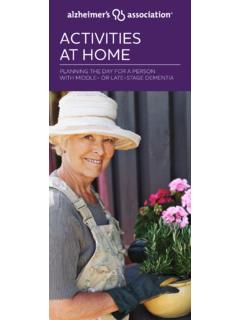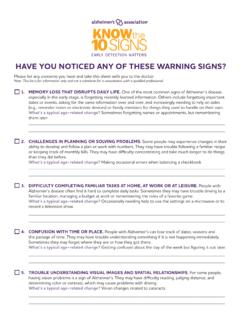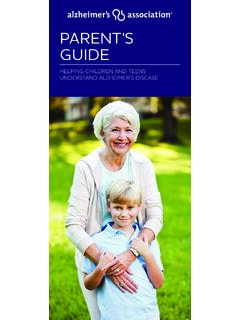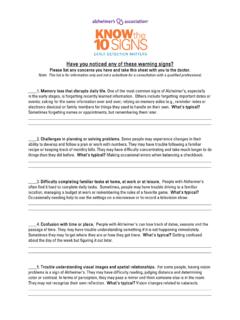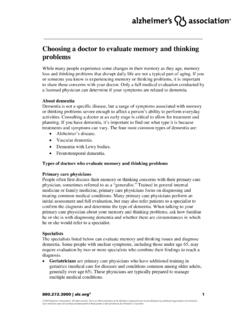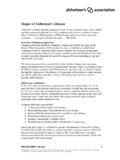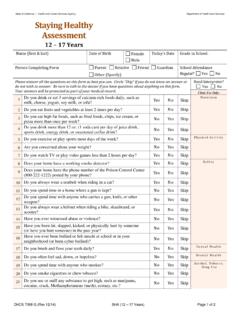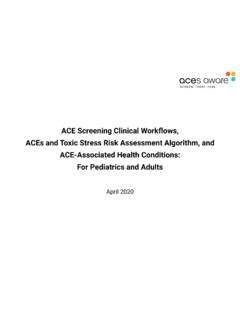Transcription of Early Identification, Assessment, and Treatment
1 NationalChronic CareConsortiumTools forEarly Identification, assessment , and Treatmentfor People withAlzheimer s DiseaseandDementiaA publication of the Chronic Care Networksfor Alzheimer s Disease initiativeNationalChronic CareConsortiumPage 2 Tools for Early Identification, assessment , and Treatment for Peoplewith Alzheimer s Disease and DementiaTable of ContentsChronic Care Networks for Alzheimer s Disease: About the Initiative .. 3 Tools for Early identification of Dementia .. 4 Flowchart for Tools for Early identification of Dementia .. 5 Early identification Tool 1: Alzheimer s Association Ten Warning Signs .. 6 Early identification Tool 1: Patient Behavior Triggers for Clinical Staff .. 7 Early identification Tool 1: Symptoms That May Indicate Dementia .. 8 Early identification Tool 2: Family questionnaire .. 9 Early identification Tool 2: Use of the Family questionnaire .. 10 Rationale for the Removal of the High-Risk Screening Tool .. 11 Initial Dementia assessment for Primary Care Providers: Three Levels of Investigation.
2 13 Level 1: For All Patients .. 14 Attachment 1: Mini-Mental State Examination (MMSE) .. 15 Attachment 2: Geriatric Depression Scale (GDS) andSingle-Item Depression Indicator .. 16 Attachment 3: Functional Activities questionnaire (FAQ) .. 17 Attachment 4: Activities of Daily Living (ADL) .. 18 Attachment 5: MBR Caregiver Strain Instrument .. 19 Attachment 6: Cognitive Incapacity & Problem Behaviors assessment .. 21 Level 2: For Most Patients ..22 Level 3: For Some Patients .. 23 Care Management Blueprints for Alzheimer s Disease .. 24 Domain 1: Patient Function .. 25 Domain 2: Caregiver Support .. 26 Domain 3: Medical Care .. 27 Domain 4: Psychosocial ..28 Domain 5: Patient Nutrition .. 29 Domain 6: Advance Directives Planning .. 30 Living with Dementia: Caregiver Support Planning Tool .. 31 Six-Phase Model for Helping Families with Alzheimer s Disease .. 33 Programs and Materials for People with Alzheimer s Diseaseand Related Disorders:Prediagnostic Phase.
3 35 Diagnostic Phase .. 36 Role-Change Phase .. 37 Chronic Caregiving Phase .. 38 Transition to Alternative Care Phase .. 39 End-of-Life Phase .. 40 NationalChronic CareConsortiumPage 3 Chronic Care Networks for Alzheimer sDisease: About the InitiativeChronic CareNetworks forAlzheimer sDiseaseBetween 1998 and 2003 national and local partnerships of the Alzheimer s Association andNational Chronic Care Consortium (NCCC) members demonstrated that networks of inte-grated care, support, and education can be developed to incorporate the range of servicesneeded by people with dementia and can function under risk-based managed care financing ortraditional Medicare. Furthermore, these networks result in high levels of satisfaction on thepart of participating patients, family caregivers, primary healthcare providers, and Alzheimer sAssociation chapter staff. (See latest evaluation reports at )The national and local partners are committed to ongoing dissemination of user-friendlyproducts, materials, tools, program descriptions, and other innovations developed throughthe demonstration.
4 The materials that follow are current as of the date at the bottom of thispage. Changes can and will be made to these materials as the experience of initiativeimplementation and evaluation suggests otherwise noted, the tools and information in this publication were developed by theCare Management Advisory Group and the Education and Support Advisory Group of theChronic Care Networks for Alzheimer s Disease (CCN/AD) initiative. Duplication foreducational and clinical purposes is authorized without prior written approval if acknowl-edgment is given to the National Chronic Care Consortium and the Alzheimer s Associationas the source. Notification of use and suggestions for improvement are appreciated. Contactthe National Chronic Care Consortium, 8100 26th Avenue South, Suite 120, Bloomington,MN latest version of these tools along with descriptive material about the conduct of theinitiative and its research results can be found on the NCCC Web site at Management Advisory Group (1997 development period)Kathryn Borgenicht, ; Kenneth Brummel-Smith, ; Susan Denman, ; PeterEngel, ; Alan Lazaroff, ; Katie Maslow; Jon Mertz; Cheryl Phillips, ;Elizabeth Pohlmann; John SelstadEducation and Support Advisory Group (1997 development period)Pauline Bourgeois, ; Wayne Caron, ; Helen Ann Comstock; Elizabeth Edgerly, ; Katie Maslow; Elizabeth McKinney; Linda Mitchell; Kim Peloso; Theresa Polich.
5 John Selstad 1998 National Chronic Care Consortium and the Alzheimer s Association Revised June 2003 NationalChronic CareConsortiumPage 4 Tools for Early identification ofDementiaDementia is very prevalent among the elderly but is often overlooked even by skilledclinicians. Clues to the presence of dementia may be subtle and nonspecific. Unrecognizeddementia may lead to iatrogenic illness, unnecessary workups driven by vague symptoms,inappropriate and costly utilization of hospital and emergency room care, and poor out-comes. Improving our ability to recognize dementia is a key first step toward improvingthis widespread Chronic Care Networks for Alzheimer s Disease Early identification process uses twotools to identify people who may have dementia and should receive a full assessment . Theflowchart on the next page illustrates the Early identification 1: Education and Awareness Materials TriggersThe Early identification process is based on recommendations from the Agency for HealthCare Policy and Research (AHCPR) Clinical Practice Guideline, Early identification ofAlzheimer s and Related Dementias.
6 * This clinical practice guideline recommends the useof triggers to identify people with possible CCN/AD initiative uses separate but somewhat overlapping sets of triggers from threesources. These are: The Alzheimer s Association publication, Ten Warning Signs of Alzheimer s Disease A list of patient behavior triggers for clinical staff developed by the Care ManagementAdvisory Group of the CCN/AD The triggers recommended in the AHCPR Clinical Practice Guideline, EarlyIdentification of Alzheimer s and Related Dementias*The triggers should be used creatively in training sessions to increase awareness of demen-tia among all care system staff, health plan enrollees, and families. Useful strategies willvary in each health plan and clinic but may include training physicians and other staff,sending regular publications to enrollees, and displaying posters and pamphlets in clinicwaiting 2: Family QuestionnaireFamily members are likely to be aware of signs and symptoms of possible dementia that arenot readily apparent to clinical who are identified as possibly having dementia by the triggers (Tool 1) and/or theFamily questionnaire should receive an Initial Dementia : Until February 2001 CCN/AD used a third tool that has been removed from theCCN/AD model based on the rational on page May 2003 1998 National Chronic Care Consortium and the Alzheimer s Association*Source:Costa, P.
7 T., Jr., T. F. Williams, M. Somerfield, et al. 1996. Early identification of Alzheimer s Disease andRelated Dementias. Clinical Practice Guideline, Quick Reference Guide for Clinicians, No. , Md.: Department of health and Human Services. AHCPR Publication No. CareNetworks forAlzheimer sDiseaseNationalChronic CareConsortiumPage 5 Flowchart for Tools for Early Identificationof DementiaMedical office staff and health planenrollees and their families recognizesigns and symptoms of possibledementia based on triggers from theAlzheimer s Association s TenWarning Signs, the list of patientbehaviors for clinical staff, and theAHCPR guidelinesFamily questionnaire indicatespossible dementiaUse care management tool andfamily support toolDiagnosis of dementiaInitial Dementia AssessmentMonitor byreassessingtriggers andadministeringMMSE every 6monthsTreat andreassessNegativeworkupDelirium ordepressionUncertainresults 1998 National Chronic Care Consortium and the Alzheimer s Association Revised February 2001 NationalChronic CareConsortiumPage 6 Early identification Tool 1 Alzheimer s Association Ten Warning SignsThe Alzheimer s Association developed the following checklist of common symptoms.
8 (Some of them also may apply to other dementing illnesses.) Individuals with several ofthese symptoms should see a physician for a complete :Alzheimer s Disease and Related Disorders Association, Inc. 2003. Ten Warning Signs of Alzheimer sDisease. This tool can be accessed at loss. One of the most common Early signs of dementia is forgettingrecently learned information. While it s normal to forget appointments, names, ortelephone numbers, those with dementia will forget such things more often and notremember them performing familiar tasks. People with dementia often find it hard tocomplete everyday tasks that are so familiar we usually do not think about how todo them. A person with Alzheimer s may not know the steps for preparing a meal,using a household appliance, or participating in a lifelong with language. Everyone has trouble finding the right word sometimes,but a person with Alzheimer s disease often forgets simple words or substitutesunusual words, making his or her speech or writing hard to understand.
9 If a personwith Alzheimer s is unable to find his or her toothbrush, for example, the individualmay ask for that thing for my mouth. to time and place. It s normal to forget the day of the week orwhere you re going. But people with Alzheimer s disease can become lost on theirown street, forget where they are and how they got there, and not know how to getback or decreased judgment. No one has perfect judgment all of the time. Thosewith Alzheimer s may dress without regard to the weather, wearing several shirts orblouses on a warm day or very little clothing in cold weather. Individuals withdementia often show poor judgment about money, giving away large amounts ofmoney to telemarketers or paying for home repairs or products they don t with abstract thinking. Balancing a checkbook may be hard when thetask is more complicated than usual. Someone with Alzheimer s disease couldforget completely what the numbers are and what needs to be done with things.
10 Anyone can temporarily misplace a wallet or key. A personwith Alzheimer s disease may put things in unusual places: an iron in the freezer ora wristwatch in the sugar in mood or behavior. Everyone can become sad or moody from time totime. Someone with Alzheimer s disease can show rapid mood swings from calmto tears to anger for no apparent in personality. People s personalities ordinarily change somewhat withage. But a person with Alzheimer s disease can change a lot, becoming extremelyconfused, suspicious, fearful, or dependent on a family of initiative. It s normal to tire of housework, business activities, or socialobligations at times. The person with Alzheimer s disease may become verypassive, sitting in front of the television for hours, sleeping more than usual, or notwanting to do usual May 2003 NationalChronic CareConsortiumPage 7 Early identification Tool 1 Patient Behavior Triggers for Clinical StaffThis idea for physician office staff training was developed by the Care Management Advisory Group of theChronic Care Networks for Alzheimer s Disease initiative and is the joint property of the National Chronic CareConsortium and the Alzheimer s Association.
